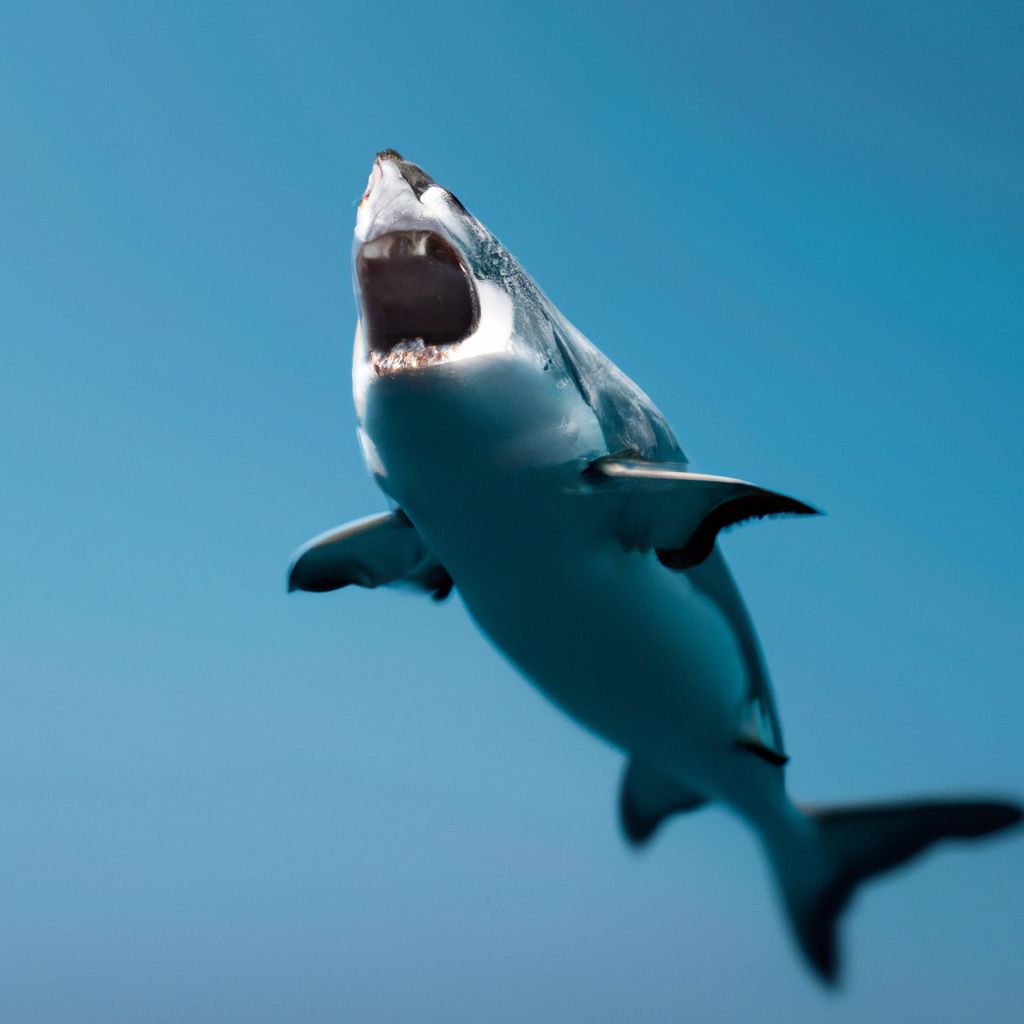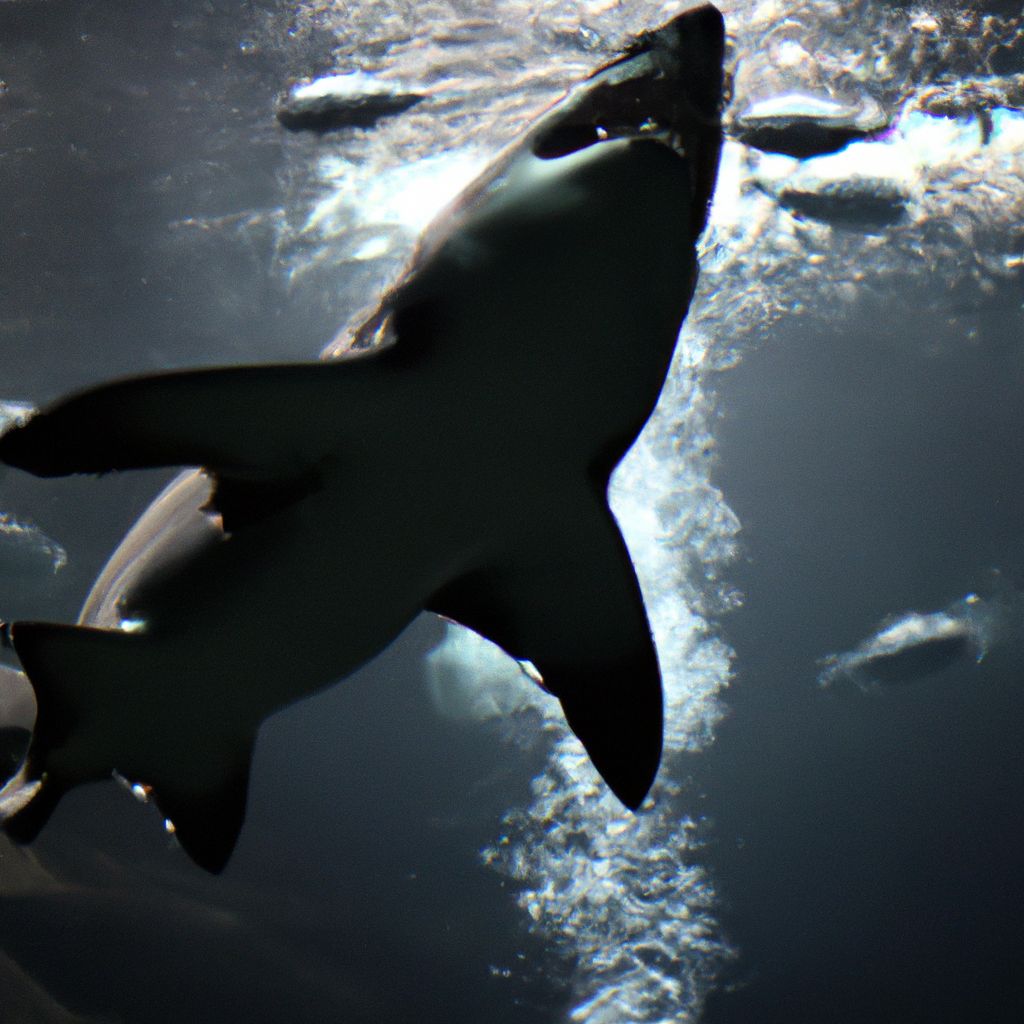
The great white shark is a fearsome predator. But how do they attack? With sharp teeth and a powerful sense of vibration, researchers have become fascinated by their hunting strategies. They’ve coined it “bump and bite,” where they rush up from below and take a powerful bite.
These creatures are adaptable too. They can stealthily ambush their prey or launch an attack from below. They show off superior hunting instincts.
Human encounters have also been recorded. Off the coast of South Africa, a female diver had a run-in with one of these majestic creatures. It serves as a reminder of their danger and awe-inspiring beauty.
Let us explore the depths of knowledge and uncover the mysteries beneath.
Key Takeaways
- Great white sharks primarily use a technique called “ambush predation” to attack their prey. They remain hidden beneath the water’s surface and then launch a surprise attack from below.
- These sharks have a unique hunting strategy that involves breaching the water’s surface to catch their prey. They propel themselves out of the water, often with their entire body exposed, to catch fast-moving prey such as seals.
- Great white sharks have an incredible sense of smell, which helps them locate potential prey from miles away. They can detect even the tiniest traces of blood in the water, allowing them to find injured or weakened animals.
- Contrary to popular belief, great white sharks do not typically target humans as prey. Most attacks on humans are cases of mistaken identity, where the shark mistakes a person for its usual prey.
- The force and power behind a great white shark’s bite are immense. Their jaws are lined with rows of sharp, serrated teeth that can easily tear through flesh and bone.
- Great white sharks are apex predators, meaning they have no natural predators in the ocean. They play a crucial role in maintaining the balance of marine ecosystems by controlling the populations of their prey.
- Despite their fearsome reputation, great white sharks are a vulnerable species and face numerous threats, including overfishing, habitat destruction, and climate change. Conservation efforts are crucial to protect these magnificent creatures and ensure their survival.
Characteristics of Great White Sharks
Great white sharks stand out from other types of sharks due to their unique qualities.
Firstly, they have a large and powerful build, measuring up to 15 feet in length and weighing up to 2,500 kilograms. They also have an iconic look with a sleek, torpedo-shaped body and rows of sharp, serrated teeth. Moreover, they can detect the faintest traces of blood from miles away due to their amazing sense of smell.
Their hunting behavior is quite extraordinary – they can launch themselves out of the water while attacking their prey, known as breaching. This increases their chances of a successful attack.
If you ever come across a great white shark, it’s important to remain calm and avoid sudden movements. Generally, they are not interested in humans as prey, but may investigate unknown objects or creatures in their environment.
Hunting Behavior of Great White Sharks

Great White Sharks have a unique hunting style! To get a better understanding, let’s check out some data in a table:
| Hunting Technique | Prey Targeted | Success Rate |
|---|---|---|
| Ambush Attack | Seals | 55% |
| Surface Feeding | Fish | 70% |
| Breaching | Marine mammals | 80% |
| Scavenging | Carcasses | 90% |
These sharks employ different approaches depending on their prey. The most common technique is the ambush attack from below. They also surface feed, breach, and scavenge to get their meals.
A unique detail is their ability to breach out of the water during an attack. This increases their chance of success and catches marine mammals off guard.
Factors that Influence Great White Shark Attacks

To comprehend Great White Shark assaults, we need to ponder their conduct designs and refuge inclinations.
Prey accessibility, ecological conditions, human collaboration, and individual shark conduct characteristics like animosity, all assume a job.
Their sharp sense of smell lets them detect even minor hints of blood from miles away. This improves their chasing proficiency and builds the possibility of assaults.
Despite their ubiquity in mainstream society, Great White Shark assaults are moderately uncommon. Though, when they do occur, they are usually because of an arrangement of natural elements meeting up with the shark’s natural impulses.
The International Shark Attack File (ISAF) detailed 57 unprovoked occurrences involving Great White Sharks worldwide in 2020.
Shark Attacks
Shark attacks are a fascinating and worrying topic. Scientists and the public are curious as to why these incidents occur. To comprehend them, we must understand the predatory nature of sharks. Contrary to belief, they don’t attack people randomly. Their usual prey are seals, sea lions, and other marine animals. But, sometimes, mistaken identity or curiosity can lead to danger.
A diverse range of species can be involved in shark attacks. Great whites often get the blame, but several other types have attacked humans. This adds complexity to understanding these incidents.
To stay safe when in waters with sharks, it’s best to be alert and follow local advice. Staying away from areas with poor visibility or high baitfish concentrations can reduce the chance of encountering sharks. However, diving with great whites is like playing a game of hide and seek – they’re good at seeking and you’re just good at hiding your fear!
Safety Measures and Precautions
When it comes to great white sharks, safety is key. Here are 3 things to consider:
- Stay alert: Look for dorsal fins, splashing water, and birds diving into the water.
- Avoid swimming alone: Sharks are more likely to attack individuals, so swim in a group.
- Respect their territory: Great whites have their own habitats. Don’t enter or disturb them. Plus, they can smell blood and fish bait. So, stay away from places where these scents could be.
To stay safe:
- Use protective enclosures in known shark areas.
- Learn about shark behavior and signs of their presence.
By following these steps, you can enjoy the ocean and coexist with sharks peacefully. Stay watchful!
Case Studies and Notable Attacks
Case studies and notable attacks provide valuable insights into great white shark behavior and hunting strategies. Let’s explore a few noteworthy incidents!
Guadalupe Island, Mexico – In 2008, divers witnessed a great white shark ambushing a seal in shallow waters.
False Bay, South Africa – In 2005, an incredible sighting saw a great white shark leaping out of the water to catch a cape fur seal near Seal Island.
Farallon Islands, California – Two biologists observed an incredible event in 1997, with multiple great whites attacking a gray whale carcass.
This data is vital for protecting both humans and marine animals living in shark-inhabited habitats. To minimize risks associated with human-shark interactions, scientists suggest implementing comprehensive public education programs and enforcing responsible ecotourism practices. Advanced monitoring systems can provide real-time information on shark movements in coastal areas.
By taking proactive measures, we can ensure peaceful coexistence between humans and great white sharks. Conservation efforts and shark education can help us swim safely in our oceans.
Conservation Efforts and Shark Education
Conservationists work hard to keep great white sharks alive and protect our oceans. One way is by setting up marine protected areas and having sustainable fishing practices. They also engage people in educational activities to show the importance of sharks for healthy marine environments, and break stereotypes.
Researchers also study sharks to know more about their behaviour and habitats. This helps conservationists use resources wisely and make sure their efforts are effective.
Plus, responsible ecotourism that observes great white sharks without disrupting them can help us appreciate them without hurting them. It’s clear that these predators know how to make a statement with their unique hunting style!
Frequently Asked Questions
1. How do great white sharks attack their prey?
Great white sharks typically use two main methods to attack their prey. The first method is the “ambush attack,” where they remain hidden and stealthily approach their prey before launching a sudden attack. The second method is the “surge-and-bite attack,” where they swim quickly towards their prey, gaining momentum, and then bite with incredible force.
2. What makes great white sharks such effective hunters?
Several factors contribute to the great white shark’s effectiveness as a hunter. First, they have powerful jaws filled with sharp teeth designed to tear through flesh. Second, their streamlined bodies allow them to swim quickly and efficiently. Lastly, their sensory organs, including their keen sense of smell and electroreception, help them locate prey from a distance.
3. Are humans the preferred prey of great white sharks?
No, humans are not the preferred prey of great white sharks. They primarily feed on marine mammals such as seals, sea lions, and smaller sharks. However, mistaken identity or curiosity can sometimes lead to shark attacks on humans.
4. How often do great white shark attacks on humans occur?
Great white shark attacks on humans are rare. According to the International Shark Attack File (ISAF), there were only 71 confirmed unprovoked attacks worldwide in 2020, and of those, 10 were fatal. The chances of encountering a great white shark and experiencing an attack are incredibly low.
5. How can humans protect themselves from great white shark attacks?
To minimize the risk of a shark attack, it is advised to avoid areas known for great white shark activity. If swimming or surfing in potential shark-infested waters, stay in groups, avoid isolated areas, and avoid wearing shiny jewelry or bright-colored clothing that may resemble a prey animal. Additionally, be cautious around areas where seals and sea lions gather, as they are known prey for great white sharks.
6. What should you do if you encounter a great white shark?
If you find yourself in the presence of a great white shark, it is crucial to remain calm. Avoid splashing or making sudden movements. Back away slowly without turning your back on the shark. If the shark approaches you, try to maintain eye contact and assert your dominance by making yourself appear larger. Slowly and cautiously make your way to safety.
Conclusion
We’ve delved into great white sharks’ attack strategies. Their jaws, teeth and speed are impressive. But there’s still more to uncover!
These apex predators use camouflage to blend in with their environment, making it harder for prey to spot them. This allows them to stalk their victims silently before attacking.
References
Shark Facts: Attack Stats, Record Swims, More (nationalgeographic.com)




